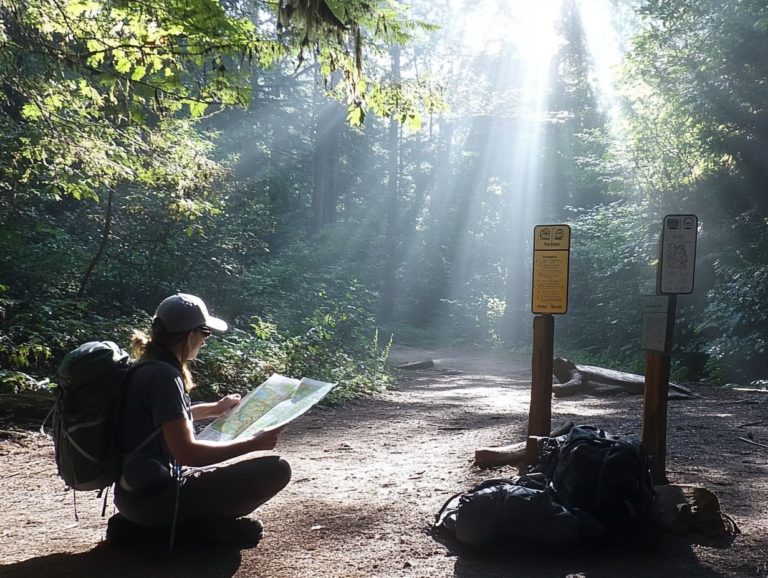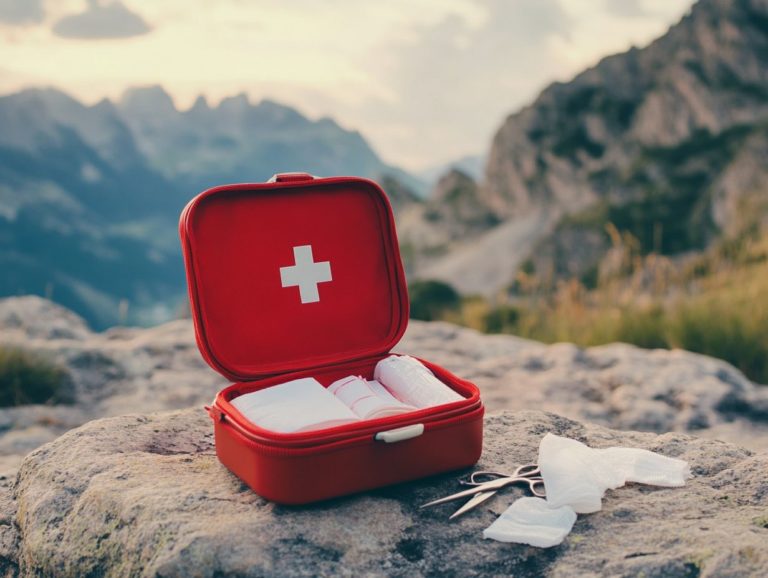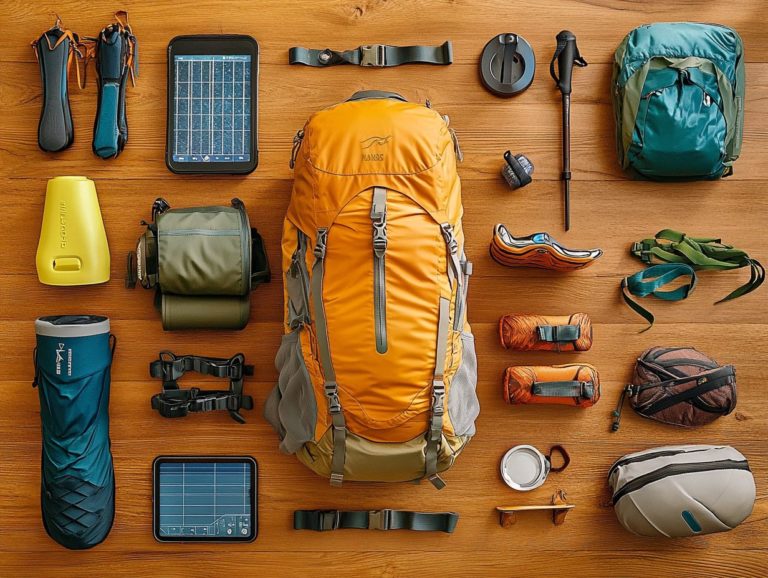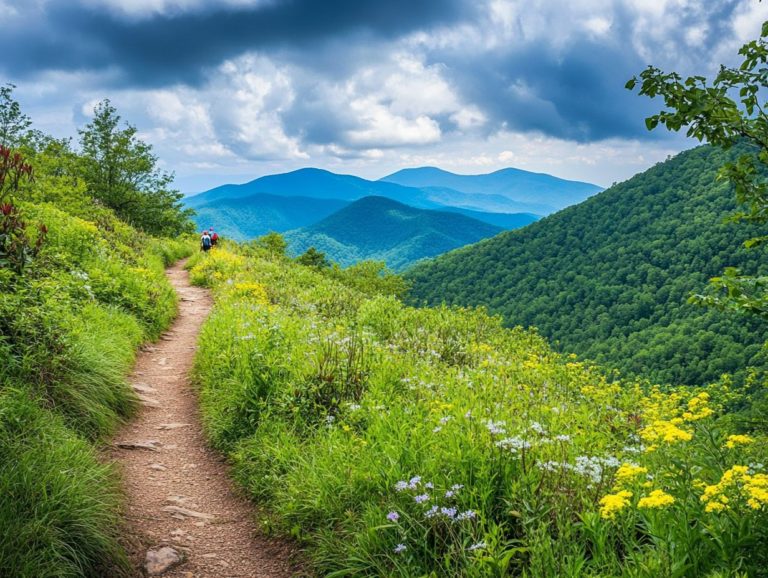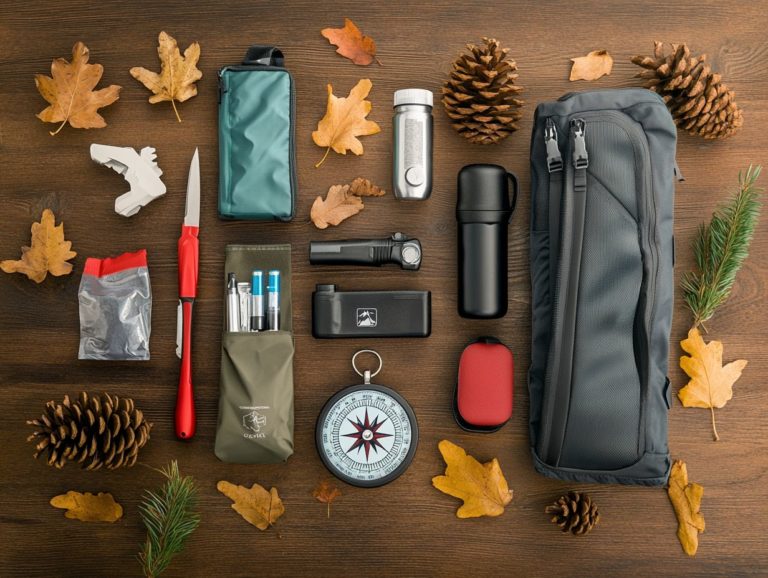Essential Hiking Gear for Beginners
Ready to embark on your first hiking adventure? The right gear can truly transform your journey from a mere trek to an unforgettable experience.
This hiking guide serves as your go-to resource for essential hiking equipment, specifically designed for beginners like you. From choosing the ideal footwear to selecting navigation tools, we ll explore everything you need to ensure you re thoroughly prepared for the trails that lie ahead.
You ll discover tips on selecting the right gear, sidestepping common pitfalls, and packing efficiently for your hiking adventures. Get ready to tackle the trails with confidence!
Contents
- Key Takeaways:
- 1. Proper Footwear
- 2. Comfortable and Breathable Clothing
- 3. A Durable Backpack
- 4. Navigation Tools
- 5. Hydration System
- 6. First Aid Kit
- 7. Sun Protection
- 8. Insulation Layers
- 9. Multi-Purpose Knife
- 10. Headlamp or Flashlight
- 11. Emergency Shelter
- 12. Rain Gear
- 13. Trekking Poles
- 14. Insect Repellent
- 15. Personal Items (ID, Phone, etc.)
- What Are the Essential Items for a Day Hike?
- Frequently Asked Questions
- What is considered essential hiking gear for beginners?
- Do I need to invest in expensive hiking gear as a beginner?
- Why is having a backpack important for hiking?
- What type of clothing should I wear for hiking?
- How much water should I bring for a beginner hike?
- Why is a first aid kit important for hiking?
Key Takeaways:
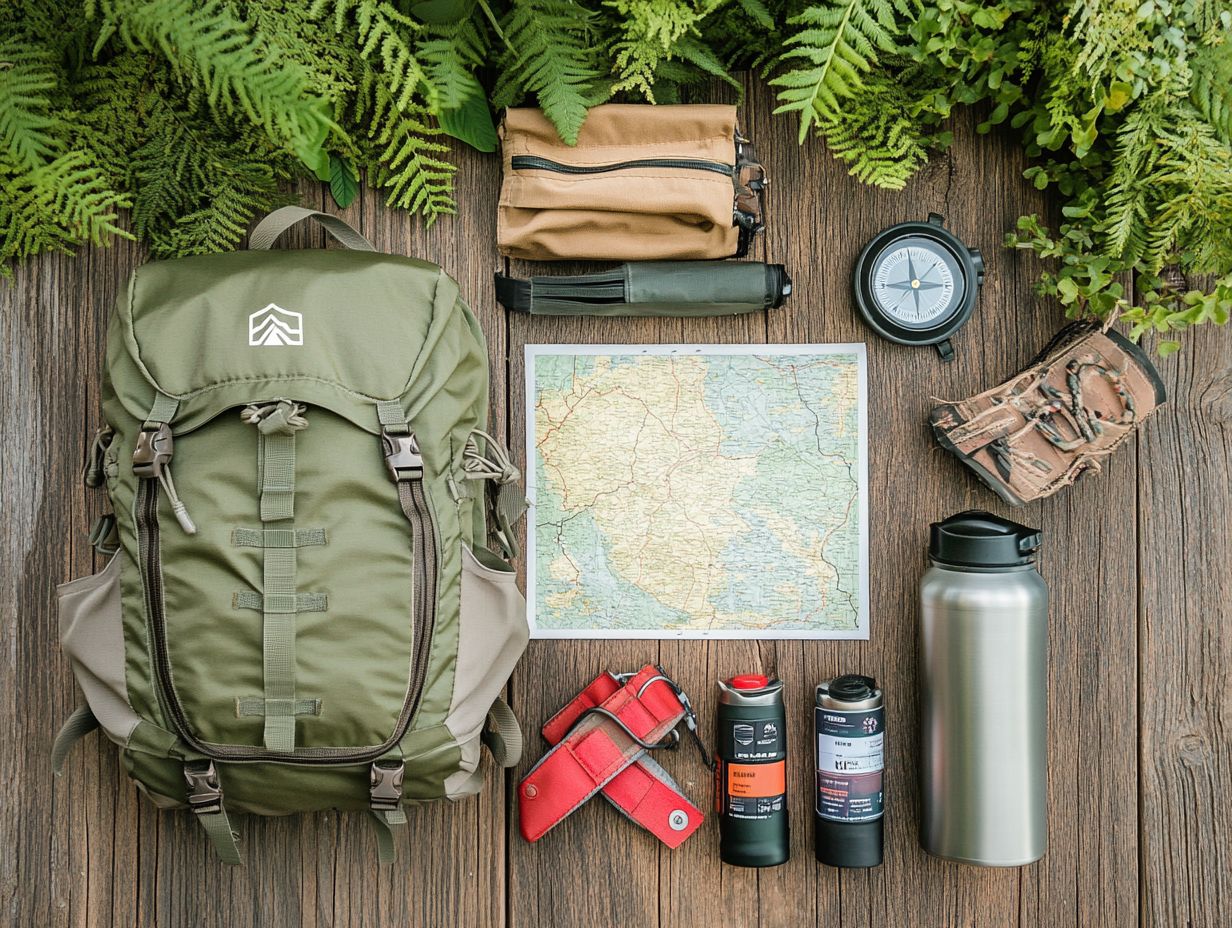
- Proper footwear is essential for a comfortable and safe hiking experience, especially for beginners.
- Comfortable and breathable clothing keeps you cool and dry on the trail.
- A durable backpack lets you carry all your gear and distribute weight comfortably.
1. Proper Footwear
Proper footwear is absolutely essential for an enjoyable hiking experience, especially for you as a beginner navigating diverse trail conditions. The right hiking shoes or boots not only safeguard your feet but also enhance your overall adventure by providing stability on rugged terrains, preventing blisters, and offering crucial ankle support during those long treks.
Different hiking styles call for specific types of footwear tailored to meet the demands of the terrain and the hike’s duration. If you’re a day hiker, lightweight, breathable shoes that offer excellent traction will serve you well. For those who venture into backpacking, mid- to high-cut boots are your best bet, as they provide added ankle support and durability when carrying heavier loads. Thru-hikers, on the other hand, should seek a harmonious balance of lightweight comfort and support, often gravitating toward shoes crafted for long-distance hikes.
When selecting the right size, remember to account for thicker socks and any foot swelling that might occur during extended outings. Gradually breaking in new shoes is crucial to avoid discomfort or injuries on the trail. Insights from the American Hiking Society emphasize the importance of trying on various options and evaluating features like waterproofing, tread pattern, and cushioning to ensure you achieve optimum performance.
2. Comfortable and Breathable Clothing
Choosing comfortable and breathable hiking clothing is vital for your hiking journey. It dramatically influences your experience and equips you to handle varying weather conditions while respecting trail etiquette the basic rules to follow while hiking to respect nature and other hikers. Opting for fabrics that draw sweat away from your body allows for optimal temperature regulation, keeping you dry and comfortable, whether you re trekking through the summer heat or the brisk chill of autumn.
When planning your hike, explore the different types of fabrics available. Synthetic materials like polyester and nylon excel in moisture management and quick drying, making them perfect for humid conditions. Conversely, merino wool provides exceptional insulation and temperature control, making it an excellent choice for cooler climates.
Layering becomes essential; a breathable base layer, an insulating mid-layer, and a waterproof outer shell create a versatile system that ensures your comfort in fluctuating weather. By dressing appropriately, you not only enhance your own safety but also foster a positive experience for your fellow hikers.
3. A Durable Backpack
A durable backpack is essential for hiking. It carries your gear and enhances your experience with comfort and support.
When planning your hike, consider the volume of your backpack. It should accommodate your gear, snacks, and hydration system.
The fit and adjustability are crucial. Make sure it suits your body type perfectly.
There are various types of backpacks designed for different journeys.
- Day hiking packs, ranging from 15 to 30 liters, are lightweight and easy to access. They are perfect for short trips.
- For overnight trips, choose a 40 to 60-liter backpack. It balances capacity with features for organizing your overnight gear.
- For longer treks, multi-day packs over 60 liters provide space and better weight distribution.
Efficient packing enhances your comfort. Place heavier items close to your back and keep frequently used gear easily accessible.
Effective navigation tools are vital for all hikers. They ensure your safety and boost your confidence on new trails.
Use traditional tools like maps and compasses alongside modern GPS devices. This combination enhances your ability to select and follow the right trail.
Familiarize yourself with these tools, as each has a unique purpose. For example, GPS apps track your location, while knowing how to read a map and use a compass is invaluable, especially when the signal is weak.
As you study maps, look for lines that indicate steepness. Use your compass to find your direction.
By incorporating navigation skills into your plans, you’re better prepared for unexpected detours. This preparation enhances your overall safety and enjoyment of the adventure.
5. Hydration System
Staying hydrated is crucial during hikes. A good hydration system greatly influences your safety and enjoyment.
Whether you choose a hydration pack or water bottles, ensure you have enough water. This helps prevent fatigue and keeps your energy high so you can enjoy the outdoors.
In warmer weather, dehydration can sneak up on you. Plan your water intake based on the hike’s length and expected weather conditions.
A good rule is to drink about half a liter of water for every hour of moderate exertion. Adjust this based on your sweat rate and altitude.
Consider portable filtration systems or electrolyte tablets to enhance hydration effectiveness. By preparing in advance, you prioritize hydration and maintain high stamina and enjoyment throughout your adventure.
6. First Aid Kit
A well-stocked first aid kit is an important part of your hiking gear checklist, offering peace of mind and the capability to tackle injuries and emergencies that may arise on your outdoor adventures. By ensuring your first aid kit contains the right essentials like bandages, antiseptic wipes, and pain relievers you can dramatically improve your hiking experience and be ready for any unexpected scenarios.
Think about adding items such as gauze pads and adhesive tape, which are crucial for treating larger wounds. A space blanket can also be a lifesaver in cases of hypothermia. Don t forget a pair of tweezers; they re invaluable for removing splinters or ticks, preventing minor annoyances from escalating into serious issues!
Make your kit personal! Tailor it based on how long you’re out and who you’re with. For longer treks, consider packing additional supplies or medications, and if you re hiking with a larger crew, extra items can be instrumental in managing multiple injuries if they occur. Always take the time to reevaluate your kit after each trip so you can replenish used items and adapt to new hiking conditions.
7. Sun Protection
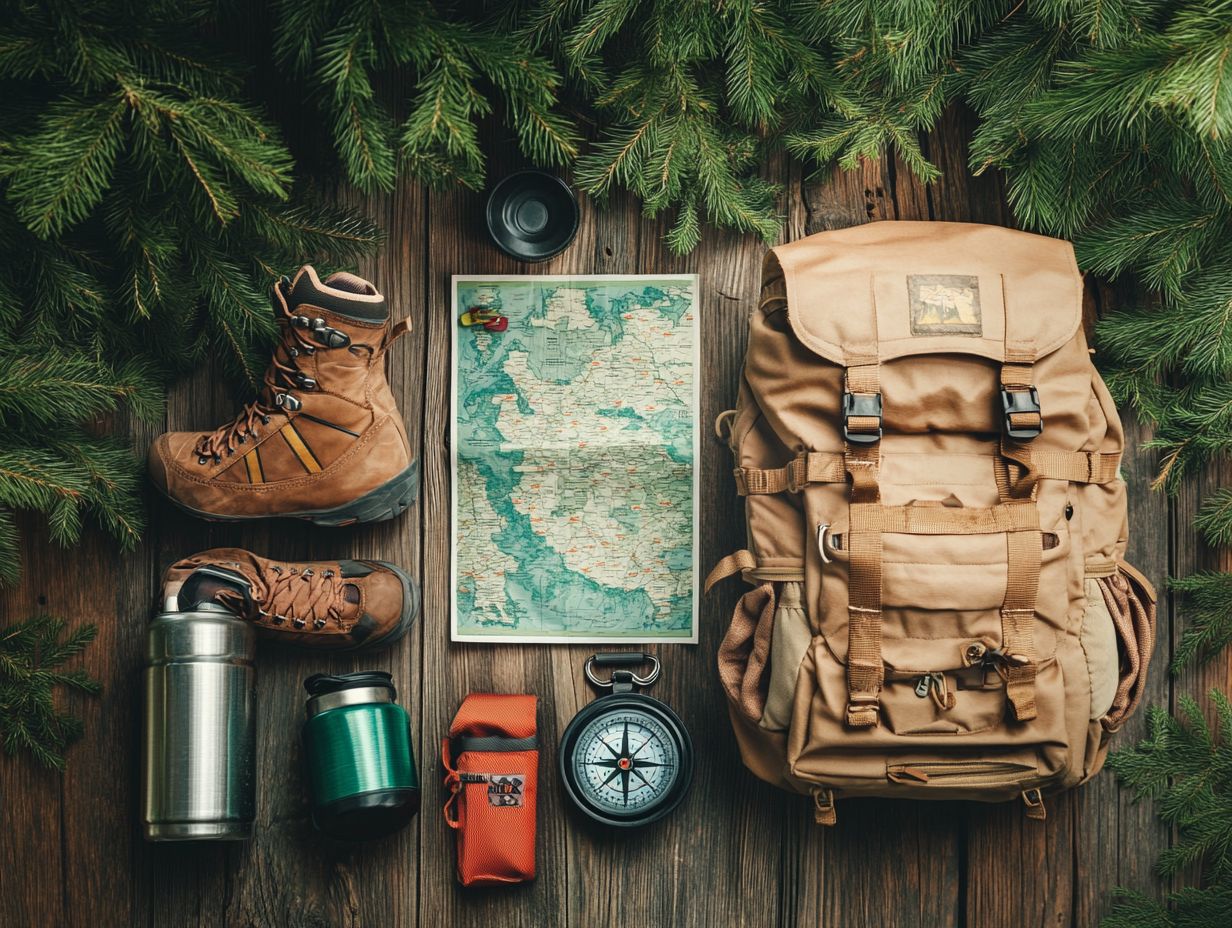
Sun protection is essential for any hiker like you, as extended exposure to UV rays (ultraviolet rays) can lead to serious health risks, including sunburn and long-term skin damage. By using a combination of sunblock, UV-blocking clothing, and protective accessories, you ll stay safe while enjoying nature, no matter the weather.
To effectively shield yourself from harmful rays, apply a quality sunscreen with at least SPF 30 generously to all exposed skin, reapplying every two hours or immediately after swimming or sweating. When you embark on outdoor activities, particularly long hikes, don t forget to wear wide-brimmed hats and UV-blocking sunglasses; these can significantly reduce sun exposure to your face and eyes.
Choosing clothing made from tightly woven fabrics with UPF ratings (Ultraviolet Protection Factor) will further enhance your protection. Lastly, seek shade during peak sun hours typically between 10 a.m. and 4 p.m. to keep this smart strategy in mind while planning your outdoor adventures.
8. Insulation Layers
Insulation layers are essential for maintaining your body temperature during hikes, particularly in unpredictable weather where temperatures can swing dramatically. When you understand how to layer effectively with materials like fleece or down, you gain the ability to regulate your warmth and comfort, ultimately enhancing your outdoor experience.
Beyond just keeping warm, a smart layering strategy is crucial for managing moisture, too. A typical three-layer system featuring a moisture-wicking base layer, an insulating mid-layer, and a protective outer shell provides the versatility you need to adapt to various climates and the anticipated duration of your hikes.
Regarding gear selection, lightweight options are ideal for short, high-energy adventures in milder climates, while heavier insulation may be necessary for longer treks in colder regions. By carefully choosing the right materials and mastering the layering principle, you ll stay comfortable and safe, no matter what weather conditions you face.
9. Multi-Purpose Knife
A multi-purpose knife is an essential tool for hikers, offering a range of functions that elevate both safety and convenience on your journeys. Whether you find yourself needing to cut rope, prepare a meal, or tackle minor repairs, having a reliable knife by your side can profoundly enhance your hiking experience, no matter the trail conditions.
These versatile tools are available in an array of designs, from compact pocket knives equipped with essential blades and screwdrivers to more robust survival knives featuring additional tools like fire starters and can openers. For instance, foldable models are perfect for lightweight hiking, while fixed blades offer superior durability for rugged terrains.
When choosing the ideal knife, it s crucial to consider the specific activities you have planned be it cooking or setting up camp and ensure that your selected tool has all the necessary functions. Evaluating safety features, such as blade locking mechanisms and comfortable grips, can further promote a worry-free hiking adventure.
10. Headlamp or Flashlight
Having a reliable headlamp or flashlight is essential for you, as a hiker, especially when navigating low-light conditions during early morning or late evening outings. These tools enhance your hiking experience by ensuring safe passage and provide an added layer of security by keeping visibility high in uncertain trail conditions.
Choosing between a headlamp and a flashlight often boils down to your personal preference and specific needs. Headlamps offer the convenience of hands-free operation, which is very useful when setting up camp or maneuvering tricky paths. Conversely, a flashlight can deliver a focused beam of light that you can easily direct.
However, flashlights can be cumbersome when you need to juggle multiple tasks. Think about the terrain and duration of your hike; for longer treks or more complex conditions, a headlamp’s versatility may serve you better. Ultimately, evaluating factors like brightness, battery life, and comfort will help you find the perfect light source for your adventures.
11. Emergency Shelter
An emergency shelter is an essential piece of hiking gear. It offers protection against unpredictable weather and unexpected situations that could threaten your safety during outdoor adventures. With a reliable emergency shelter, you’ll feel confident stepping into the great outdoors, regardless of the challenges you might face on the trail.
There are several options for emergency shelters to consider. Bivy sacks, which are small, weatherproof bags for sleeping, are ideal for solo travelers. Meanwhile, tarps provide versatile coverage for larger groups. Understanding the nuances of these shelters is crucial; for example, bivy sacks shine in harsh wind or rain, while tarps can be configured for spacious accommodations across various terrains.
Quick setup is vital in stressful situations, so practicing your shelter assembly ahead of time can make all the difference. To set up your emergency shelter efficiently, follow these steps:
- Find a flat, dry area.
- Ensure that the wind is at your back.
- Secure the corners or ties firmly to withstand the elements.
Carrying stakes or using rocks can enhance stability, helping you create a safe haven in no time.
12. Rain Gear
Investing in quality rain gear is essential for you as a hiker, especially since unpredictable weather can swiftly transform an enjoyable hike into a more challenging ordeal. With items like waterproof jackets and breathable pants, having the right gear keeps you dry and enhances your safety and comfort during wet conditions.
When selecting your rain gear, prioritize features such as breathability, which allows moisture to escape while keeping water at bay. Lightweight materials facilitate easier movement, helping you avoid fatigue on longer trails. Also, packability ensures your gear can be tucked away effortlessly when not in use. Look for options with adjustable hoods and cuffs for extra protection against wind and rain.
Don’t get caught in the rain without proper gear! Regular maintenance is equally important; you should clean your gear following the manufacturer s instructions and consider using a waterproofing spray periodically. This practice helps restore effectiveness and extend the lifespan of your essential hiking equipment, ensuring you re always prepared for whatever weather nature throws your way.
13. Trekking Poles
Trekking poles are a very useful addition to your hiking gear, offering stability and support as you navigate various trail conditions. By using these poles, you can significantly reduce the impact on your knees and enhance your overall hiking experience, making even the most challenging terrain feel more manageable.
They improve your balance on uneven surfaces and serve as critical protection for your joints against excessive strain. When selecting the perfect trekking poles, consider factors like your height, preferred material whether aluminum or carbon fiber and the specific types of hiking you plan to pursue.
If you often find yourself in rugged areas, lightweight and durable options will likely serve you best. Taller hikers should prioritize adjustable poles to ensure optimal comfort and effectiveness on every adventure.
14. Insect Repellent
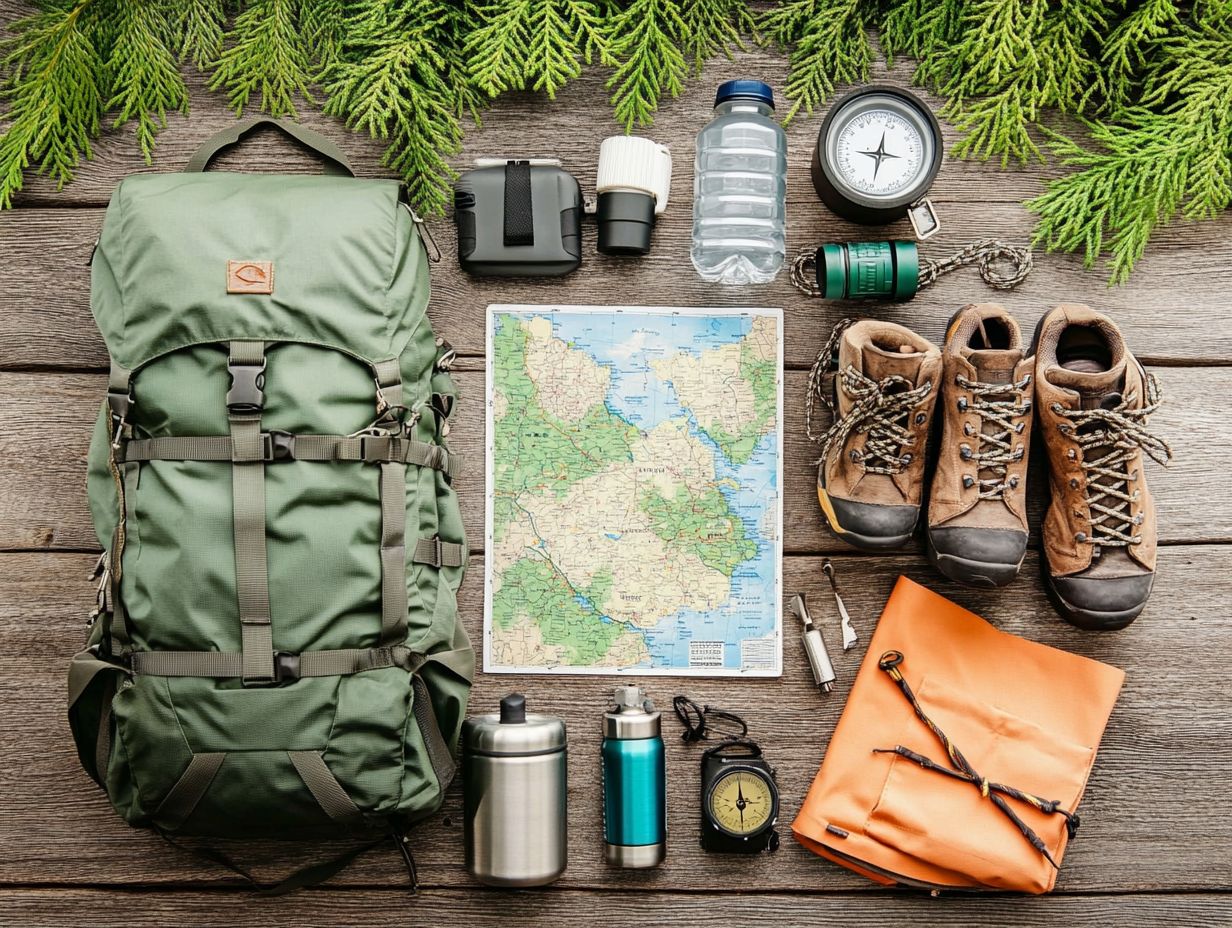
Insect repellent is a top priority for hikers! It offers essential protection against bites that can cause discomfort or serious health risks during your adventures.
This crucial gear comes in various forms, from synthetic chemical repellents containing DEET (a common chemical used to keep bugs away) and picaridin to natural alternatives like citronella oil and eucalyptus. Chemical options are known for long-lasting effectiveness against mosquitoes and ticks, while natural repellents appeal to eco-conscious hikers.
When choosing an insect repellent, think about the pests in your hiking area and how long you ll be outdoors. Apply the repellent generously to exposed skin and clothing, and remember to reapply every few hours, especially after sweating or getting wet!
15. Personal Items (ID, Phone, etc.)
Carrying essential personal items, like your identification and cell phone, is vital for any hiker! This not only offers convenience but significantly boosts your safety.
These items help you navigate trails and provide emergency contacts at your fingertips for swift assistance. Adding navigation tools, such as a map or compass, adds an extra layer of security in unfamiliar areas.
To keep these critical items safe, use waterproof pouches or zippered pockets that are easy to reach but won t hinder your movement. Regularly check that your equipment is functioning properly and charge your devices before heading out!
What Are the Essential Items for a Day Hike?
Planning for a day hike means thoughtfully selecting items that enhance your safety, comfort, and enjoyment. Key items to consider include:
- Proper footwear
- A reliable backpack
- Hydration systems
- Navigation tools
- Personal gear
All these should be tailored to your hiking experience and the trail conditions.
A sturdy pair of hiking boots provides essential support and traction, reducing your risk of injury. A well-fitted backpack not only carries your gear but also distributes weight evenly for a more comfortable hike.
Hydration systems keep your energy up, especially when the sun is shining brightly. Navigation tools, like maps or GPS devices, help you stay on course. Don t forget the weather bringing items like a rain jacket, sunscreen, or extra layers can greatly enhance your outdoor experience!
Effective planning combined with the right gear equips you to handle whatever nature throws your way. So, check your gear before heading out, and get ready for your adventure!
What Are the Essential Items for an Overnight Hike?
Overnight hikes require careful planning and gear. You’ll need essential items to stay safe and comfortable during your adventure.
Key items include a sturdy tent or emergency shelter, appropriate sleeping gear, and sufficient food and hydration tailored to the specific trail conditions and weather.
Pack a compact stove and cooking utensils for warm meals, along with a reliable headlamp or flashlight to guide you after sunset.
Lightweight packing is crucial; every ounce counts and can affect your overall endurance and enjoyment on the trail. Focus on items that serve multiple purposes to enhance your efficiency while addressing safety concerns.
Keep a first-aid kit nearby and ensure you have adequate layering for changing temperatures. This can greatly improve your comfort and safety throughout the night.
How Can a Beginner Determine the Right Gear for Them?
Choosing the right hiking gear can be overwhelming for beginners, but a structured approach makes it enjoyable. Start by identifying the type of hiking you plan to undertake whether it’s Day Hiking, Backpacking, Fastpacking, or Thru-hiking.
Consider trail conditions, weather, and safety concerns to make informed choices that suit your adventure.
Your experience level plays a big role in gear selection. As a novice, you might prefer lighter options for ease, while seasoned trekkers may choose durable, multi-purpose items that last.
Exploring local hiking trails and assessing their challenges will help you find the right fit for your skill and confidence levels.
Utilize resources like the American Hiking Society for invaluable insights tailored to various hiking styles. Local hiking clubs can connect you with experienced hikers offering hands-on advice and support.
Together, these tools will enhance your planning process, ensuring you feel fully prepared and excited to hit the trail.
What Are Some Common Mistakes to Avoid When Choosing Hiking Gear?
Choosing the right hiking gear can be exciting, but there’s a learning curve involved. As a beginner, you might fall into common traps that could impact your safety and enjoyment on the trail.
Be aware of pitfalls like underestimating the importance of quality equipment, ignoring the weather forecast, or skipping the gear testing phase. Avoiding these can greatly enhance your hiking experience.
Conduct thorough research before making any purchases. Reach out to experienced hikers or guides; their insights into what gear works best in different conditions can be invaluable.
Many local outdoor shops are eager to offer expert advice. Some even allow you to test gear in-store, helping you make well-informed decisions.
Always check product reviews and understand the nuances in gear specifications to avoid costly mistakes later. Ultimately, dedicating time to preparation and seeking guidance will lead to a hiking experience that is both enjoyable and safe.
How Can One Properly Pack and Distribute Weight in Their Backpack?
Properly packing and distributing weight in your backpack is essential for staying comfortable and balanced on your hikes. It reduces strain and significantly enhances your overall experience.
Place heavier items closer to your back and centered between your shoulder blades. This allows lighter items to be stored in external pockets or at the top of your pack for easy access.
Keep in mind that different backpack designs may require unique packing strategies. For example, a top-loading backpack invites a different orientation of items compared to a front- or side-loading pack.
When packing a top-loader, consider placing bulkier gear, such as tents or sleeping bags, at the bottom for a low center of gravity. Keep snacks and extra layers within reach at the top.
If you’re using a framed pack, stowing heavier gear against your back helps distribute weight more effectively, enhancing stability as you move.
Organizing items in compartments or using packing cubes helps keep your items organized and easy to find, ensuring your essential gear is readily available without rummaging through your entire pack.
Frequently Asked Questions
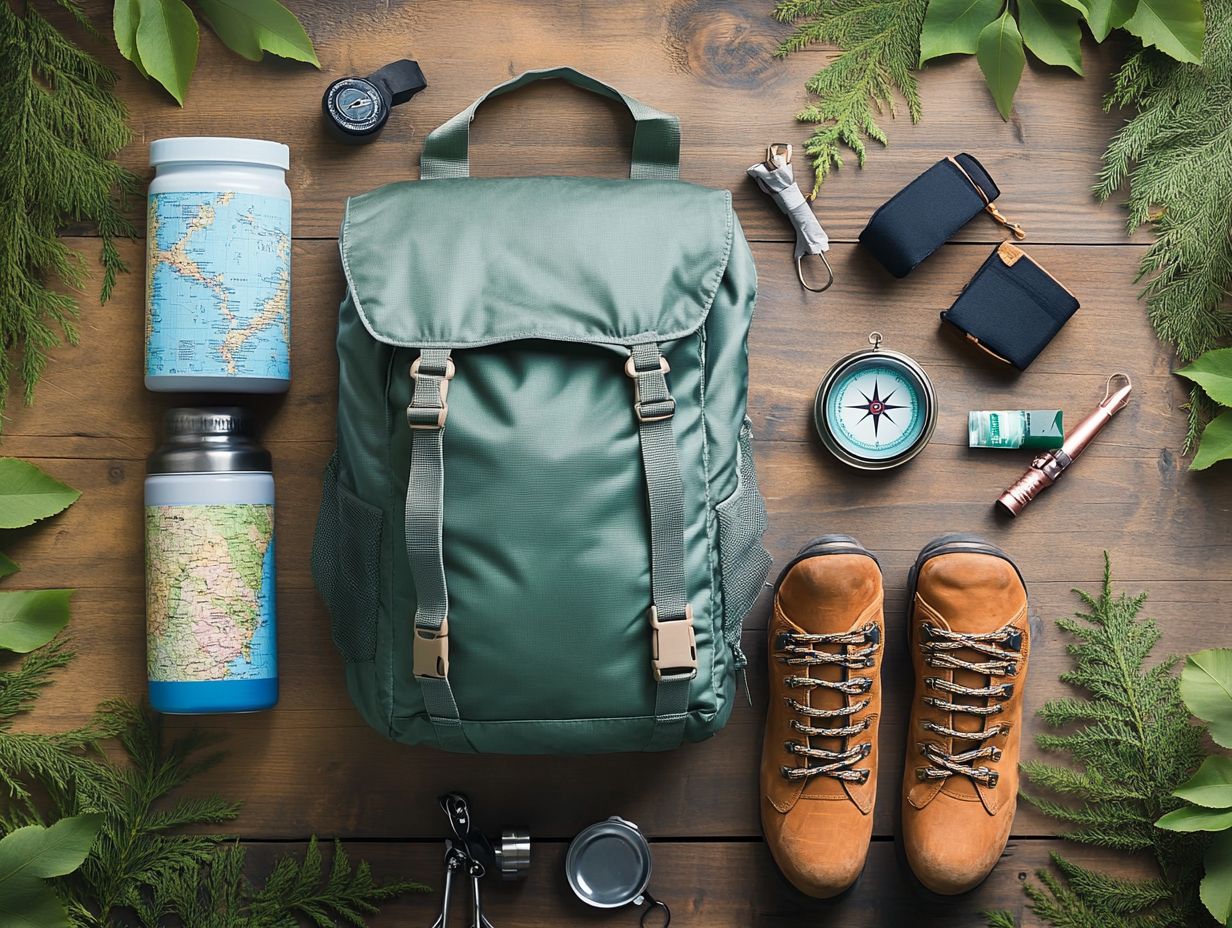
What is considered essential hiking gear for beginners?
- Comfortable and sturdy hiking boots
- A backpack
- A water bottle
- Navigation tools
- A first aid kit
- Appropriate clothing for the weather
Do I need to invest in expensive hiking gear as a beginner?
No, you do not need to spend a lot of money on hiking gear as a beginner. Look for affordable options or consider renting gear until you are sure that hiking is a hobby you want to continue.
Why is having a backpack important for hiking?
A backpack is important for hiking as it allows you to carry all your essential gear, food, and water comfortably. It also distributes the weight evenly, preventing injuries or strain on your body.
What type of clothing should I wear for hiking?
You should wear comfortable and breathable clothing for hiking, such as moisture-wicking shirts, quick-drying pants, and layers for weather changes. Avoid cotton as it retains moisture and can cause discomfort or chafing.
How much water should I bring for a beginner hike?
As a general rule, you should bring at least 2 liters of water for a beginner hike. This amount can vary depending on the length and difficulty of the trail, as well as the weather conditions. It’s always better to bring more water than you think you’ll need.
Why is a first aid kit important for hiking?
A first aid kit is essential for hiking as it allows you to treat minor injuries and prevent them from becoming more serious. It should include items like bandages, antiseptic wipes, pain relievers, and blister treatments.
Pack wisely to enjoy your adventure fully!

